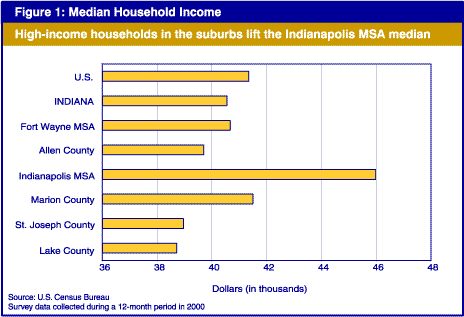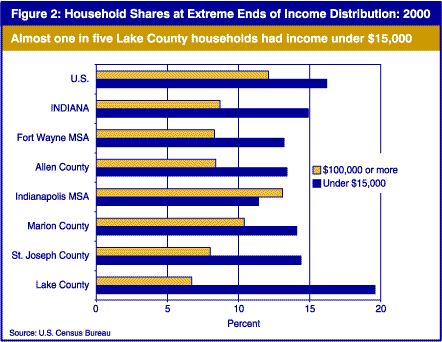Income Data Revealed in Census Survey
Among all the data items collected in the decennial census and other ongoing government surveys, income is certainly one of the most important to business people. The population of a state or county represents more than just constituents, taxpayers, drivers or school children; it represents potential consumers of private sector goods and services as well. And, of course, income is a key factor in judging the attractiveness of a market for almost any provider of goods or services.
Income data from Census 2000 are not available yet, but results from a large household survey called the Census 2000 Supplementary Survey (C2SS) have been released for all 50 states, as well as for cities and counties with populations of 250,000 or more. For Indiana, income data are now available for the state, four counties, and two metropolitan areas.
The C2SS, like the census long form, includes questions about the income of each household member age 15 or older. Responses are aggregated and reported as household income. There are various measures of household income, but the single best summary measure for any given geographic area is probably the median: the dollar figure that splits the area's household income distribution in half.
Figure 1 compares the median household income estimate, as reported in C2SS, for the United States, Indiana, and the state's largest counties and metropolitan areas. Median household income was estimated at $40,552 in Indiana and $41,349 across the entire United States. The nine-county Indianapolis MSA surpassed the state and nation by a considerable margin, with an estimated median of $45,990, while Marion County's median was $41,500. Although the C2SS sample size was not large enough to provide a separate estimate for the eight "doughnut" counties surrounding Marion County, the wide difference between the MSA and Marion County can only be attributed to higher income levels in the suburban counties.

A unique feature of the C2SS data set is the inclusion of 90-percent confidence interval estimates along with the point estimate for each data item. Because of sample size limitations, the confidence interval can be quite wide for Indiana counties, while it is smaller for the state and much narrower for the nation. To illustrate, the confidence interval for Indiana's median household income ranges from $39,414 to $41,691, compared with the national figure of $41,197 to $41,501. Since there is some overlap in these two intervals, we cannot conclude that the difference in median household income between Indiana and the United States is statistically significant. Phrased another way, the difference between the U.S. and Indiana medians could be due to sampling error rather than any real differences in income characteristics. An examination of household income estimates for the eight areas reported in Figure 1 reveals that differences between and among seven areas are not statistically significant. Only the Indianapolis MSA median income can be asserted to be significantly different from the other areas.
A second way to compare income across geographies is to examine the distribution of households within defined income ranges. The share of households in the lowest income range presents an indicator of the prevalence of poverty in the area. Similarly, the household share in the highest income range can give a clue to the relative affluence of a state or county. A brief review of household shares at each extreme of the income distribution paints a picture, however incomplete, of relative equity or inequity in the distribution of income.
Figure 2 depicts C2SS household shares at extreme ends of the income spectrum, with the low end defined here as less than $15,000 and the high end defined as more than $100,000. The chart shows that in 2000, low-income households outnumbered those at the high end in each of the reported geographies, with the exception of the Indianapolis MSA. The nine-county metropolitan area also appears to have the most equitable income distribution, based on the limited evidence presented here, because it has the smallest gap between the two income bars. The most inequitable distribution of income is found in Lake County, where almost one in five households had income under $15,000 in the past 12 months, but only one in 15 had income over $100,000. The Lake County gap between high- and low-income household shares was 13 percentage points, more than double the size of the next largest gap, six points, for the state and St. Joseph County.

A comparison between Indiana and the United States yields mixed results. The nation has higher household shares at each end of the spectrum, suggesting that Indiana is at once neither as wealthy nor as poor as the rest of the nation. In the sub-$15,000 income category, the difference in household shares between the U.S. and Indiana was only one percentage point. At the high end, however, the spread between Indiana and the U.S. was three points. This means that low-income households are nearly as common in Indiana as they are at the national level, but households with six-figure incomes are considerably harder to find in the Hoosier state than in the rest of the nation.
